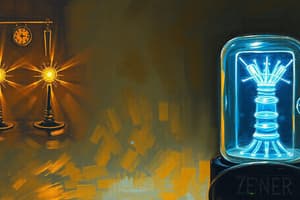Podcast
Questions and Answers
What happens in a zener diode when the applied voltage is lower than the Zener voltage?
What happens in a zener diode when the applied voltage is lower than the Zener voltage?
- Current flows through the diode
- Power dissipation increases significantly
- Voltage across the diode decreases
- No current flows through the diode (correct)
How does a zener diode behave when the reverse bias voltage exceeds the Zener voltage?
How does a zener diode behave when the reverse bias voltage exceeds the Zener voltage?
- It acts like an open circuit
- It dissipates more power
- It decreases its Zener voltage
- It conducts like a resistor (correct)
Which of the following is NOT an application of zener diodes?
Which of the following is NOT an application of zener diodes?
- Voltage Stabilizers
- Current Limiting
- Signal Amplification (correct)
- Reference Voltage Source
What is the main purpose of using zener diodes in voltage stabilizers?
What is the main purpose of using zener diodes in voltage stabilizers?
In which situation would a zener diode start conducting current?
In which situation would a zener diode start conducting current?
What characteristic makes zener diodes useful in applications involving precision voltage control?
What characteristic makes zener diodes useful in applications involving precision voltage control?
What characteristic of zener diodes makes them suitable for precision voltage control applications?
What characteristic of zener diodes makes them suitable for precision voltage control applications?
How does the resistance of a zener diode change as the voltage increases?
How does the resistance of a zener diode change as the voltage increases?
What happens when the applied voltage exceeds the Zener voltage in a zener diode?
What happens when the applied voltage exceeds the Zener voltage in a zener diode?
How do zener diodes act in terms of voltage regulation in electronic circuits?
How do zener diodes act in terms of voltage regulation in electronic circuits?
How can a stable output voltage be achieved using a zener diode in an electronic circuit?
How can a stable output voltage be achieved using a zener diode in an electronic circuit?
What can happen if the applied voltage is held above the Zener voltage for a long time?
What can happen if the applied voltage is held above the Zener voltage for a long time?
Flashcards are hidden until you start studying
Study Notes
Zener Diodes
Zener diodes are semiconductor devices that are typically used for voltage regulation and protection against overvoltage. They work by allowing current to flow through them when the applied voltage exceeds a specific value known as the Zener voltage. This property makes zener diodes useful in voltage regulation circuits and other applications involving precision voltage control.
Working Principle
In zener diodes, when the voltage applied across them exceeds a specified value called the Zener voltage (Vz), the device conducts like a resistor. This behavior occurs without any significant increase in power dissipation. When Vr < Vz (where Vr is the reverse bias voltage), no current flows through the zener diode. However, when Vr > Vz, the diode will start conducting current, maintaining the same voltage drop across the diode.
Applications
Zener diodes play important roles in various electronic devices, including:
- Voltage Stabilizers: Zener diodes are used to remove fluctuations in voltages caused by variations in supply voltage. They help maintain a constant output voltage regardless of changes in input voltage.
- Current Limiting: Zener diodes are used as current limiting components in high voltage circuits to protect the circuit from overvoltage situations.
- Reference Voltage Source: Zener diodes serve as reference voltage sources for operational amplifiers and digital circuits.
- Adjustable Voltage Source: In combination with voltage multipliers, zener diodes provide adjustable voltage levels based on the applied voltage.
Characteristics
Some notable characteristics of zener diodes include:
- Fixed Voltage: Zener diodes have a fixed voltage drop across them when conducting current, making them suitable for precision voltage control applications.
- Nonlinear Resistance: Their resistance decreases as the voltage increases until the breakdown voltage is reached.
- Voltage Regulation: They can regulate voltage by maintaining a constant voltage across the device regardless of changes in input voltage.
Reverse Breakdown
The reverse breakdown characteristic of zener diodes occurs when the applied voltage exceeds the Zener voltage. At that point, the diode conducts without any significant increase in power dissipation, effectively acting like a resistor. However, if the applied voltage is held above Vz for a long time, the diode may undergo thermal breakdown due to its high power dissipation rate. This could lead to permanent damage or failure of the diode.
Voltage Regulation
Zener diodes are commonly used as voltage regulators in electronic circuits. When a stable output voltage is required for an application, a series combination of a zener diode and a resistor can be employed. By choosing appropriate values for the zener diode and the resistor, the desired output voltage can be achieved. In such a circuit, if the input voltage varies, the zener diode will maintain the desired output voltage by adjusting the current flow through the diode.
Studying That Suits You
Use AI to generate personalized quizzes and flashcards to suit your learning preferences.




